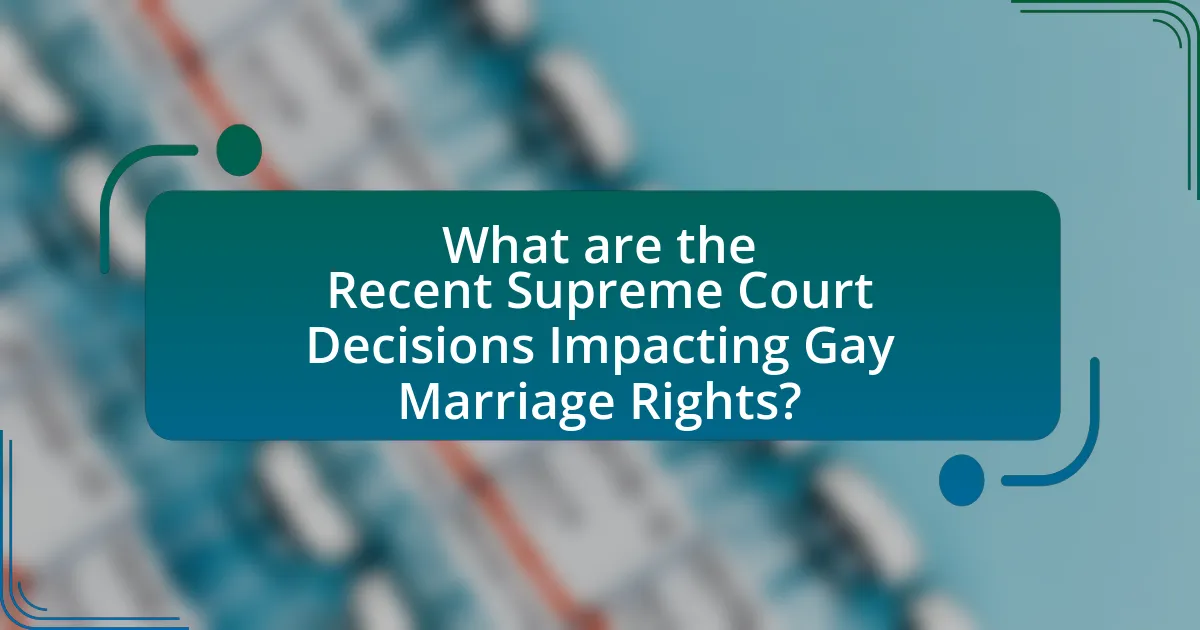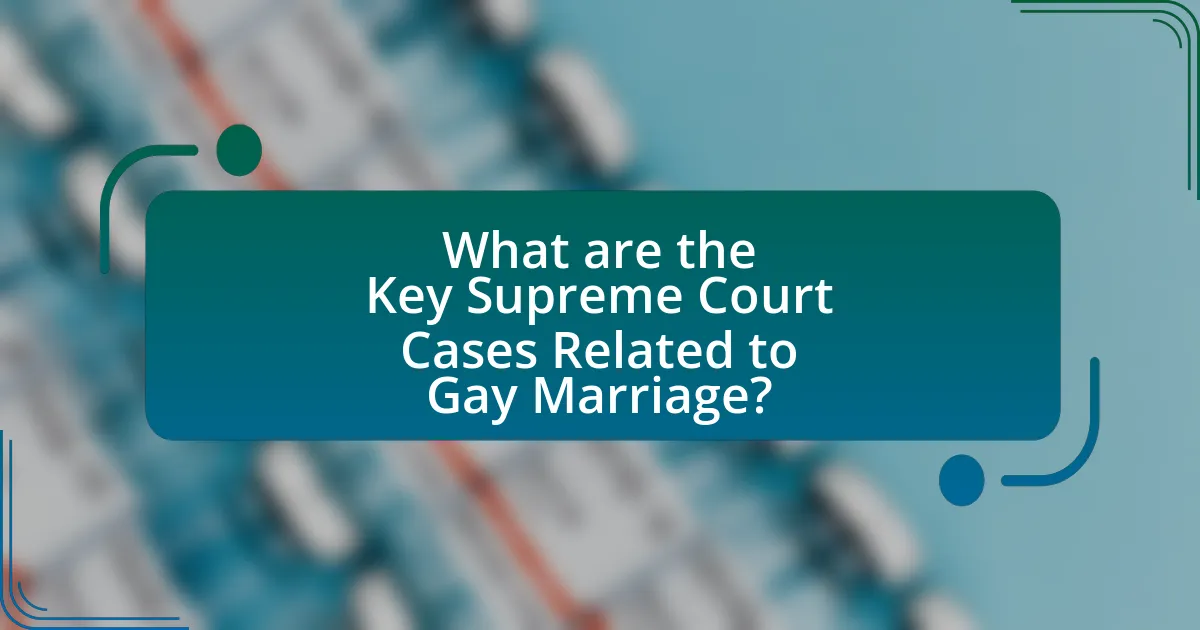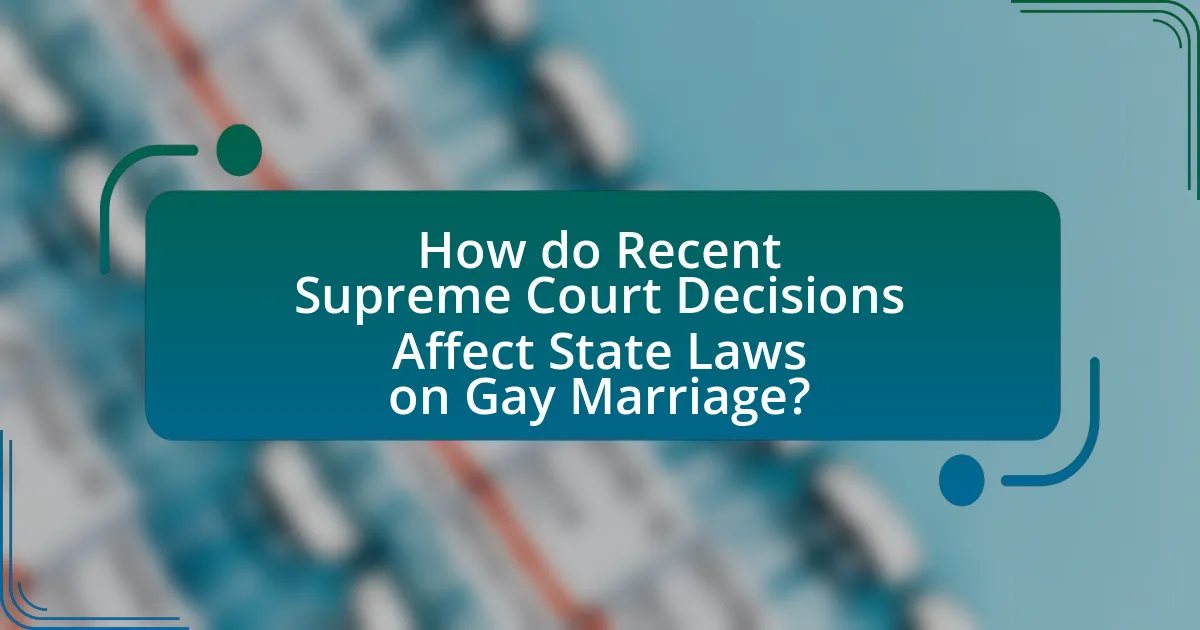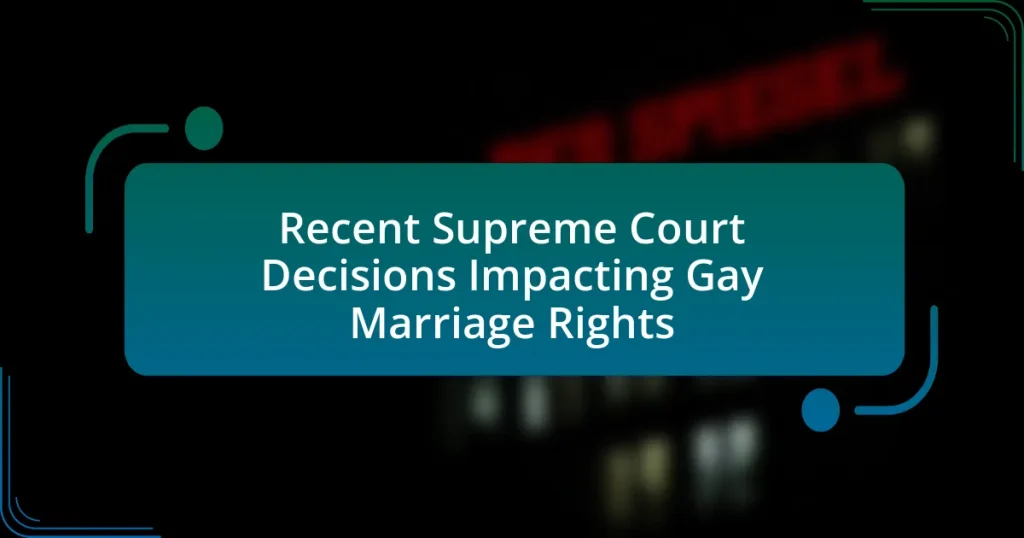The article examines recent Supreme Court decisions that have significantly impacted gay marriage rights, focusing on key cases such as Obergefell v. Hodges and Bostock v. Clayton County. It outlines how these rulings have established constitutional protections for same-sex marriage, affirming that discrimination based on sexual orientation violates federal law. The article also discusses the implications of these decisions on state laws, societal attitudes towards LGBTQ+ rights, and potential future legal challenges, highlighting the ongoing evolution of marriage equality in the United States.

What are the Recent Supreme Court Decisions Impacting Gay Marriage Rights?
Recent Supreme Court decisions impacting gay marriage rights include the 2020 case of Bostock v. Clayton County, which ruled that Title VII of the Civil Rights Act protects employees from discrimination based on sexual orientation or gender identity. This decision reinforces the legal framework supporting LGBTQ+ rights, including marriage equality, by affirming that discrimination against individuals for their sexual orientation is a violation of federal law. Additionally, the Supreme Court has not directly overturned Obergefell v. Hodges, the landmark 2015 decision that legalized same-sex marriage nationwide, indicating a continued legal recognition of gay marriage rights.
How have these decisions shaped the legal landscape for gay marriage?
Recent Supreme Court decisions have significantly shaped the legal landscape for gay marriage by establishing constitutional protections for same-sex marriage. The landmark case Obergefell v. Hodges in 2015 ruled that same-sex couples have the right to marry under the Fourteenth Amendment, effectively legalizing gay marriage nationwide. This decision invalidated state bans on same-sex marriage and reinforced the principle that marriage is a fundamental right, thereby influencing subsequent legal interpretations and policies related to LGBTQ+ rights across the United States.
What specific cases have been pivotal in influencing gay marriage rights?
The specific cases pivotal in influencing gay marriage rights include Obergefell v. Hodges (2015), United States v. Windsor (2013), and Lawrence v. Texas (2003). Obergefell v. Hodges established the constitutional right to same-sex marriage across the United States, ruling that state bans on same-sex marriage violated the Fourteenth Amendment’s Equal Protection and Due Process Clauses. United States v. Windsor struck down the Defense of Marriage Act (DOMA), which denied federal recognition of same-sex marriages, thereby allowing same-sex couples to access federal benefits. Lawrence v. Texas decriminalized same-sex sexual activity, laying the groundwork for later marriage equality cases by affirming the rights of LGBTQ+ individuals. These cases collectively advanced legal recognition and protection of same-sex marriage rights in the U.S. legal system.
How do these decisions reflect societal attitudes towards gay marriage?
Recent Supreme Court decisions regarding gay marriage reflect a significant shift in societal attitudes towards LGBTQ+ rights, indicating increasing acceptance and support for same-sex marriage. For instance, the landmark 2015 case Obergefell v. Hodges established that same-sex couples have the constitutional right to marry, which was a direct response to changing public opinion; a Gallup poll from the same year showed that 60% of Americans supported same-sex marriage, up from just 27% in 1996. This legal recognition not only validates the relationships of same-sex couples but also signifies broader societal acknowledgment of equality and civil rights, demonstrating that legal decisions are often aligned with evolving cultural norms.
Why are these decisions significant for LGBTQ+ rights?
Recent Supreme Court decisions are significant for LGBTQ+ rights because they establish legal precedents that affirm the rights of same-sex couples to marry and enjoy the same legal protections as heterosexual couples. For instance, the landmark case Obergefell v. Hodges in 2015 ruled that same-sex marriage is a constitutional right under the Fourteenth Amendment, which guarantees equal protection and due process. This decision not only legalized same-sex marriage nationwide but also reinforced the principle that LGBTQ+ individuals are entitled to the same rights and recognition as their heterosexual counterparts, thereby promoting equality and reducing discrimination.
What implications do these rulings have on future legislation?
The implications of recent Supreme Court rulings on gay marriage rights significantly influence future legislation by establishing legal precedents that may restrict or expand the scope of marriage equality. These rulings can lead to legislative bodies reassessing existing laws and potentially introducing new measures to either protect or limit rights based on the judicial interpretations. For instance, the Supreme Court’s decision in Obergefell v. Hodges (2015) legalized same-sex marriage nationwide, prompting states to align their laws accordingly. Conversely, subsequent rulings may embolden states to pursue legislation that challenges or undermines these rights, reflecting a shift in the legal landscape. Therefore, the trajectory of future legislation will likely be shaped by the ongoing interpretation of these rulings and the political climate surrounding LGBTQ+ rights.
How do these decisions affect the rights of same-sex couples across states?
Recent Supreme Court decisions significantly affect the rights of same-sex couples across states by establishing legal precedents that either protect or undermine their marriage rights. For instance, the 2015 ruling in Obergefell v. Hodges legalized same-sex marriage nationwide, affirming that state bans on same-sex marriage violate the Constitution. However, subsequent decisions have raised concerns about potential rollbacks of these rights, as some rulings allow states to enact laws that could discriminate against same-sex couples in areas such as adoption and healthcare. These legal shifts create a patchwork of protections, leading to varying rights for same-sex couples depending on the state, which can result in unequal treatment and access to benefits.

What are the Key Supreme Court Cases Related to Gay Marriage?
The key Supreme Court cases related to gay marriage are United States v. Windsor (2013) and Obergefell v. Hodges (2015). In United States v. Windsor, the Court struck down the Defense of Marriage Act (DOMA), ruling that it violated the Fifth Amendment’s guarantee of equal protection under the law, thereby allowing federal recognition of same-sex marriages. In Obergefell v. Hodges, the Court ruled that same-sex marriage is a constitutional right under the Fourteenth Amendment, mandating that states must recognize and license marriages between same-sex couples. These decisions collectively established the legal foundation for marriage equality in the United States.
What was the outcome of Obergefell v. Hodges?
The outcome of Obergefell v. Hodges was a landmark Supreme Court decision that legalized same-sex marriage across the United States. On June 26, 2015, the Court ruled in a 5-4 decision that the right to marry is guaranteed to same-sex couples under the Fourteenth Amendment’s Due Process and Equal Protection Clauses. This ruling effectively invalidated state bans on same-sex marriage, affirming that marriage is a fundamental right that cannot be denied based on sexual orientation.
How did this case redefine marriage equality in the United States?
The case Obergefell v. Hodges (2015) redefined marriage equality in the United States by ruling that same-sex marriage is a constitutional right under the Fourteenth Amendment. This landmark decision invalidated state bans on same-sex marriage, affirming that denying marriage rights to same-sex couples violated the principles of equal protection and due process. The Supreme Court’s ruling established a legal precedent that recognized the dignity and equality of same-sex couples, thereby ensuring that marriage rights are uniformly protected across all states.
What were the arguments presented by both sides in this case?
In the case regarding recent Supreme Court decisions impacting gay marriage rights, the arguments presented by proponents of gay marriage centered on the principles of equality and civil rights, asserting that denying same-sex couples the right to marry violates the Equal Protection Clause of the Fourteenth Amendment. They argued that marriage is a fundamental right that should be accessible to all individuals, regardless of sexual orientation, citing precedents such as Obergefell v. Hodges, which recognized the right to marry as a constitutional guarantee.
Conversely, opponents of gay marriage argued from a traditionalist perspective, claiming that marriage should be defined as a union between one man and one woman. They contended that the state has a vested interest in promoting traditional marriage for the sake of societal stability and child-rearing, often invoking religious beliefs and the historical definition of marriage as justification for their stance. This side emphasized states’ rights to define marriage laws according to their cultural and moral values.
What role did United States v. Windsor play in advancing gay marriage rights?
United States v. Windsor played a crucial role in advancing gay marriage rights by striking down the Defense of Marriage Act (DOMA) in 2013, which had defined marriage as a union between one man and one woman for federal purposes. The Supreme Court’s decision invalidated the federal government’s refusal to recognize same-sex marriages performed in states where they were legal, thereby granting federal benefits to same-sex couples. This ruling set a significant legal precedent that contributed to the momentum for marriage equality, ultimately leading to the Supreme Court’s decision in Obergefell v. Hodges in 2015, which legalized same-sex marriage nationwide.
What were the key legal principles established in this case?
The key legal principles established in this case include the recognition of same-sex marriage as a constitutional right under the Equal Protection Clause and the Due Process Clause of the Fourteenth Amendment. This ruling affirmed that states cannot deny marriage licenses to same-sex couples, thereby ensuring that marriage equality is protected nationwide. The decision also emphasized that the right to marry is a fundamental liberty, which is essential to individual autonomy and dignity, as supported by precedents in previous Supreme Court rulings regarding marriage rights.
How did this case influence public opinion on gay marriage?
This case significantly shifted public opinion on gay marriage by legitimizing same-sex unions in the eyes of the law. Following the ruling, surveys indicated a marked increase in support for gay marriage, with a Gallup poll showing that approval rose from 40% in 2008 to 60% in 2015, reflecting changing societal attitudes. The case also prompted discussions in media and public forums, further normalizing the concept of marriage equality and influencing political discourse, as evidenced by numerous states moving to legalize gay marriage shortly after the decision.

How do Recent Supreme Court Decisions Affect State Laws on Gay Marriage?
Recent Supreme Court decisions have significantly influenced state laws on gay marriage by establishing a constitutional right to same-sex marriage. The landmark ruling in Obergefell v. Hodges (2015) determined that state bans on same-sex marriage violate the Fourteenth Amendment’s guarantees of equal protection and due process, thereby invalidating such laws across the United States. This decision mandated that all states must recognize and perform same-sex marriages, effectively overriding any existing state laws that prohibited them. Consequently, states are now required to align their marriage laws with this federal ruling, ensuring that same-sex couples receive the same legal recognition and benefits as opposite-sex couples.
What variations exist in state responses to these Supreme Court rulings?
State responses to Supreme Court rulings on gay marriage rights vary significantly, reflecting differing political, cultural, and legal landscapes across the United States. For instance, some states have embraced the rulings by enacting laws that protect and expand LGBTQ+ rights, while others have introduced legislation aimed at undermining those rights, such as religious exemptions or restrictions on marriage licenses. A notable example is how states like California and New York have implemented comprehensive protections for same-sex couples, whereas states like Texas and Alabama have pursued measures that challenge or limit the recognition of same-sex marriages. This divergence illustrates the complex interplay between federal mandates and state-level governance, with states exercising their authority in ways that align with their local values and political climates.
How have some states attempted to circumvent these decisions?
Some states have attempted to circumvent recent Supreme Court decisions impacting gay marriage rights by enacting laws that restrict or undermine the recognition of same-sex marriages. For example, states like Alabama and Texas have passed legislation that allows for the refusal of marriage licenses to same-sex couples based on religious objections. Additionally, some states have implemented measures that limit the benefits and rights afforded to same-sex couples, such as denying them access to certain state programs or services. These actions reflect a broader trend of resistance to federal rulings, as evidenced by the introduction of bills aimed at reinforcing traditional marriage definitions and challenging the legal standing of same-sex unions.
What legal challenges have arisen in response to state laws on gay marriage?
Legal challenges arising in response to state laws on gay marriage primarily include lawsuits claiming violations of constitutional rights, such as equal protection and due process. For instance, cases like Obergefell v. Hodges (2015) challenged state bans on same-sex marriage, leading to the Supreme Court ruling that such bans were unconstitutional under the Fourteenth Amendment. Additionally, various state-level legal battles have emerged, where plaintiffs argue that state laws discriminated against same-sex couples by denying them marriage rights and benefits afforded to heterosexual couples. These challenges often cite precedents set by earlier rulings, emphasizing the evolving interpretation of civil rights in the context of marriage equality.
What are the potential future implications of these decisions?
The potential future implications of recent Supreme Court decisions impacting gay marriage rights include the possibility of increased legal challenges to existing marriage equality laws and the potential for states to enact legislation that restricts or undermines these rights. These decisions may embolden conservative lawmakers to pursue measures that could limit the scope of marriage rights for same-sex couples, as evidenced by historical trends following similar rulings, such as the backlash seen after the Obergefell v. Hodges decision in 2015, which legalized same-sex marriage nationwide. Additionally, these implications could lead to a fragmented legal landscape where marriage rights vary significantly from state to state, affecting the stability and recognition of same-sex marriages across the country.
How might upcoming Supreme Court cases impact gay marriage rights?
Upcoming Supreme Court cases may significantly impact gay marriage rights by potentially revisiting and altering precedents established in landmark rulings such as Obergefell v. Hodges, which legalized same-sex marriage nationwide in 2015. If the Court decides to hear cases challenging the legal basis for same-sex marriage or related rights, it could lead to a reevaluation of the constitutional protections afforded to same-sex couples. Historical context shows that the Supreme Court has the authority to overturn previous decisions, as seen in cases like Roe v. Wade. Therefore, the outcomes of these upcoming cases could either reinforce or undermine the legal status of gay marriage, affecting millions of individuals and families across the United States.
What can advocates do to protect and promote gay marriage rights moving forward?
Advocates can protect and promote gay marriage rights moving forward by engaging in legislative advocacy to support laws that safeguard marriage equality. This includes lobbying for the introduction and passage of bills that explicitly protect the rights of same-sex couples at both state and federal levels. For instance, the Equality Act, which aims to prohibit discrimination based on sexual orientation and gender identity, serves as a concrete example of legislative efforts that advocates can support. Additionally, advocates can mobilize grassroots campaigns to raise public awareness and support for gay marriage rights, leveraging social media and community events to educate the public on the importance of equality in marriage. Research indicates that public support for same-sex marriage has increased significantly, with a Gallup poll showing that 70% of Americans supported same-sex marriage in 2021, highlighting the potential for advocates to influence policy through public opinion.
What steps can individuals take to stay informed about gay marriage rights?
Individuals can stay informed about gay marriage rights by regularly following reputable news sources, legal blogs, and advocacy organizations focused on LGBTQ+ rights. These sources provide updates on recent Supreme Court decisions, legislative changes, and ongoing legal battles that impact gay marriage rights. For instance, organizations like the Human Rights Campaign and the American Civil Liberties Union publish timely reports and analyses on relevant court rulings and their implications. Additionally, subscribing to newsletters from these organizations can ensure individuals receive direct updates on developments in gay marriage rights.


